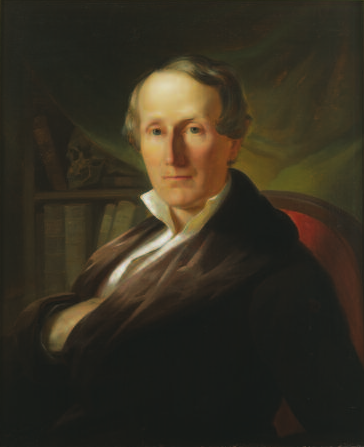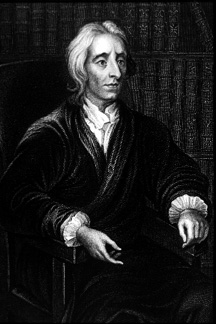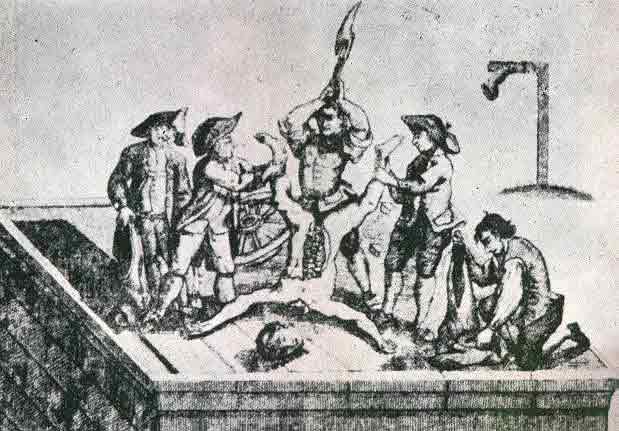Occurrences of ‘Blumenbach’ in published writings.
After a peak in the early 19th century, Johann Friedrich Blumenbach faded into
the background. He had little influence on the thinking of later
anthropologists. (source)
Stephen Jay Gould believed that the Western world
view had been perverted by the racial theorizing of anthropologists in the 18th
and 19th centuries, one of them being the American anthropologist Samuel George
Morton (1799-1851). Another was his German contemporary Johann Friedrich
Blumenbach (1752-1840):
In the eighteenth century a
disastrous shift occurred in the way Westerners perceived races. The man
responsible was Johann Friedrich Blumenbach, one of the least racist thinkers
of his day.
[…] Blumenbach chose to regard
his own European variety as closest to the created ideal and then searched for
the subset of Europeans with greatest perfection--the highest of the high, so
to speak. As we have seen, he identified the people around Mount Caucasus as
the closest embodiments of the original ideal and proceeded to name the entire
European race for its finest representatives.
[…] however subjective (and even
risible) we view the criterion today, Blumenbach chose physical beauty as his
guide to ranking. He simply affirmed that Europeans were most beautiful, with
Caucasians as the most comely of all.
[…] Where would Hitler have been
without racism, Jefferson without liberty? Blumenbach lived as a cloistered
professor all his life, but his ideas have reverberated in ways that he never
could have anticipated, through our wars, our social upheavals, our sufferings,
and our hopes. (Gould, 1994)
As Gould himself noted, Blumenbach denied that human
populations differ in mental capacity. In this, he was less racist than many other
people of his day. But he did posit differences in sexual beauty, thus ultimately
leading humanity to … Hitler.
Is this true? Yes, Blumenbach considered Europeans the
most attractive of all humans, as we may see in his work De Generis Humani Varietate Nativa:
Caucasian
variety.
Colour white, cheeks rosy, hair brown or chestnut-coloured [...] In general,
that kind of appearance which, according to our opinion of symmetry, we
consider most handsome and becoming. (Blumenbach, 1795, p. 265)
Meiners refers all nations to two
stocks: (1) handsome, (2) ugly; the first white, the latter dark. He includes
in the handsome stock the Celts, Sarmatians, and oriental nations. The ugly
stock embraces all the rest of mankind. (Blumenbach, 1795, p. 268)
Caucasian
variety.
I have taken the name of this variety from Mount Caucasus, both because its
neighbourhood, and especially its southern slope, produces the most beautiful
race of men, I mean the Georgian; and because all physiological reasons
converge to this, that in that region, if anywhere, it seems we ought with the
greatest probability to place the autochthones of mankind. For in the first
place, that stock displays, as we have seen, the most beautiful form of the
skull, from which, as from a mean and primeval type, the others diverge by most
easy gradations on both sides to the two ultimate extremes (that is on the one
side, the Ethiopian, on the other, the Mongolian) […] (Blumenbach, 1795, p.
269)
These passages, however, covered less than a page
out of a tome that ran to 276 pages. Nor did they recount anything new in the
academic or popular literature. Blumenbach simply stated what most people
of his time believed, as is implied by the above quotes. One likeminded person
was the French naturalist Georges Cuvier (1769-1832):
The white race, with its oval
face, long hair, protruding nose, to which the civilized peoples of Europe
belong, and which appears to us to be the most beautiful of all races, is also
much superior to the others by strength of genius, courage and activity.
(Cuvier, 1798, p. 71)
Another was the American President Thomas
Jefferson (1743-1826):
And is this difference [of color]
of no importance? Is it not the foundation of a greater or less share of beauty
in the two races? Are not the fine mixtures of red and white, the expressions
of every passion by greater or less suffusions of colour in the one, preferable
to that eternal monotony, which reigns in the countenances, that immoveable
veil of black which covers all the emotions of the other race? Add to these,
flowing hair, a more elegant symmetry of form, their own judgment in favour of
the whites, declared by their preference of them […] (Jefferson, 1785, p. 265)
Blumenbach did not create a perception that
Europeans were more beautiful than other humans. That perception already
existed.
Influences on
later anthropologists?
But was Blumenbach instrumental in transmitting this
perception to later anthropologists? Did he play a pivotal role in creating the
racialized mind-set of later times? That, too, is doubtful. There is a chasm
between him and his successors. Unlike the latter, he saw human diversity
through the lens of the Bible, in particular the story of the Flood. Since
Noah’s Ark came to rest on Mount Ararat, he reasoned that the inhabitants of
that region must closely resemble the humans that God chose to repeople the
Earth. From this epicenter of physical perfection, Noah’s descendants spread to
other lands and gradually became less perfect in appearance.
This view is quite unlike later ones, which were
framed in secular and evolutionary terms. For Blumenbach, change was
degenerative, moving from the perfect to the less perfect. Later
anthropologists, while accepting the possibility of degenerative change, saw a
general trend towards advancement and increasing complexity.
Like others of his time, Blumenbach also believed in
the inheritance of acquired characteristics. If people of any origin share the
same climate, diet, and means of existence, they will converge to the same
physical type—not through natural selection, but through the direct action of
the environment. In this, he was poles apart from later writers, particularly
those influenced by Charles Darwin and Gregor Mendel.
The chasm between him and later writers can be seen
in the occurrence of the term ‘Blumenbach’ in books over the years. After a
peak in the early 19th century, references to his name fell into steep decline,
long before the publication of Darwin’s Descent
of Man in 1871 (Hawks, 2013). That book had only four such references, all
of them minor.
Finally, European writers do not assign this German
naturalist a key role in the development of racial thinking. In a recent French
dictionary on the history of racism, there are entries for such individuals as
Bolk, Buffon, Darwin, Gobineau, Haeckel, Nietzsche, and Linnaeus, but none at
all for Blumenbach (Taguieff, 2013).
Famous but no
real legacy
Blumenbach, though widely respected in his time, made
few intellectual contributions that would be both lasting and original, other
than his coining of the term ‘Caucasian’ for white folks. What about the notion
that the Caucasus is the epicenter of human beauty? It was already in
circulation, as seen in this passage by the French traveler Jean Chardin
(1643-1713):
[…] the Persian blood is now
highly refined by frequent intermixtures with the Georgians and the
Circassians, two nations which surpass all the world in personal beauty. There
is hardly a man of rank in Persia who is not born of a Georgian or Circassian
mother; and even the king himself is commonly sprung, on the female side, from
one or other of these countries. As it is long since this mixture commenced,
the Persian women have become very handsome and beautiful, though they do not
rival the ladies of Georgia (Lawrence, 1848, p. 310)
The Caucasus was the last area where one could
freely buy fair-skinned women for marriage or concubinage, typically for
clients in the Middle East, North Africa, and South Asia. Previously, the zone
of recruitment had been larger, extending into what is now Ukraine and southern
Russia. Further back in time, it had covered almost all of Europe. But this earlier
page of European history was largely forgotten by Blumenbach’s time.
Blumenbach really had only one original idea. He saw
a causal link between the biblical account of the Flood and the beauty of
European women, particularly those from the Caucasus. But that single flash of
insight would leave no lasting impression on future generations.
More shenanigans
…
None of this was pointed out in 1994, when Stephen
Jay Gould published his essay on Blumenbach. Or perhaps it was. If a man shouts
in a forest and no one listens, did he ever really say anything?
Two years later, Gould incorporated this essay into
a new edition of The Mismeasure of Man.
Once again, he couldn’t resist the urge to “fudge”:
In 1996, when Gould updated The Mismeasure of Man, he added an
article about Blumenbach. It included a drawing of skulls which Gould claimed
to be an illustration from one of Blumenbach’s books. In this graphic, a
Caucasian skull is situated higher than those of other races. When a paper by
University of Tubingen historian Thomas Junker demonstrated that the original
drawing placed all the skulls at the same level, Gould blamed the mistake on
his editor saying, “I don’t think that I even knew about the figure when I
wrote the article, for I worked from a photocopy of Blumenbach’s text alone.”
Gould dismissed this error as “inconsequential” and faulted Junker for
misstating “the central thesis of my article—a misinterpretation that cannot, I
think, be attributed to any lack of clarity on my part.” (Michael, 2013)
One might wonder why Gould missed this error when he
got the galley proofs for the new edition. Furthermore, since his errors point
in the same direction, one might wonder whether there had been a systematic
tendency to distort the facts, either consciously or unconsciously. Wasn’t this
the same argument he had made when condemning Samuel George Morton?
References
Blumenbach, J.F. (1795). De Generis Humani Varietate Nativa, trans. On the Natural Variety of Mankind, 1865, London.
Cuvier, G. (1798). Tableau
elementaire de l'histoire naturelle des animaux, Paris.
Gould, S.J. (1994). The Geometer of Race, Discover Magazine, (November 1994),
online edition
http://discovermagazine.com/1994/nov/thegeometerofrac441#.UOGEqXcdOZQ
Jefferson, T. (1785). Notes on the State of Virginia,
http://etext.virginia.edu/etcbin/toccer-new2?id=JefVirg.sgm&images=images/modeng&data=/texts/english/modeng/parsed&tag=public&part=14&division=div1
Hawks, J. (2013). Blumenbach, Haeckel, Dobzhansky,
January 2, John Hawks Weblog,
http://johnhawks.net/weblog/topics/history/biology/blumenbach-haeckel-dobzhansky-2013.html
Lawrence, W. (1848). Lectures on Comparative Anatomy, Physiology, Zoology, and the Natural
History of Man, London: Henry G. Bohn.
Michael, J.S. (2013). Stephen Jay Gould and Samuel
George Morton: A Personal Commentary, Part 4, June. 14, Michael1988.com
http://michael1988.com/?p=203
Taguieff, P.-A. (ed.) (2013). Dictionnaire historique et critique du racisme, Paris: Presses
Universitaires de France.










